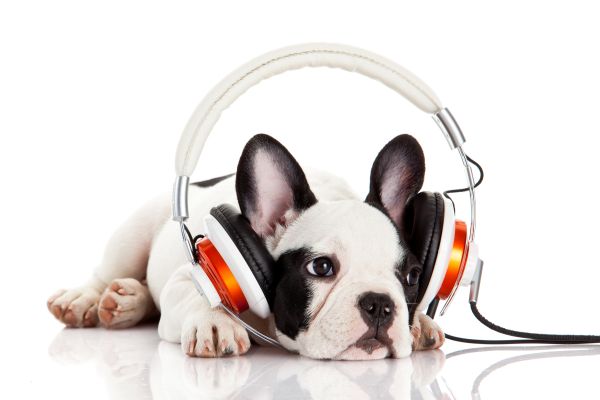Discover the wonders of auditory stimulation for dogs. This article explores how different sounds and music can significantly enhance your furry friend’s mental and emotional health.
Understanding Your Dog’s Auditory Environment Needs

In the realm of pet care, auditory stimulation for dogs is often overlooked. Yet, it’s crucial for their well-being. Firstly, dogs have a diverse range of hearing abilities. They can perceive frequencies that we humans cannot. Therefore, providing a variety of sounds can greatly enrich their environment. Moreover, auditory stimulation can prevent boredom and anxiety, especially when they are left alone. Importantly, the right sounds can soothe and relax our canine companions.
Furthermore, auditory stimulation plays a vital role in a dog’s cognitive health. As they age, maintaining a stimulating environment is key to keeping their minds sharp. Interestingly, certain types of music, like classical, have been shown to calm dogs. In contrast, harsher sounds might cause stress. Therefore, it’s essential to choose the right type of auditory input. Additionally, this stimulation can be a fun way to interact with your pet, strengthening your bond.
Lastly, auditory stimulation can be particularly beneficial for dogs with anxiety or behavioral issues. Calming sounds can provide a sense of security and comfort. For instance, playing soft music during thunderstorms or fireworks can help alleviate their fear. Also, incorporating auditory games in their routine can improve their listening skills and responsiveness. Therefore, understanding and implementing auditory stimulation can significantly enhance your dog’s quality of life, making them happier and more well-adjusted pets.
Enhancing Canine Moods with Musical Stimulation
Music’s impact on dogs is both fascinating and beneficial. Firstly, it’s important to understand that dogs perceive music differently than humans. For instance, they are more sensitive to certain frequencies. Thus, selecting the right type of music is crucial. Additionally, music can be a great tool for reducing separation anxiety in dogs. When left alone, playing soothing tunes can provide a comforting presence, helping them feel less isolated and more relaxed.
Moreover, incorporating music into training sessions can be highly effective. For example, playing calming music during training can create a relaxed atmosphere, making it easier for dogs to focus and learn. Furthermore, it’s essential to observe your dog’s reaction to different genres. Some may prefer classical music, while others might respond better to soft rock or jazz. Therefore, experimenting with various types of music can help you discover what best suits your dog’s preferences.
Lastly, the therapeutic effects of music on dogs cannot be overstated. In addition to reducing stress, music can also aid in behavioral modification. For dogs with aggressive tendencies or hyperactivity, calming melodies can help moderate their behavior. Also, for older dogs or those recovering from illness, music can provide a soothing and healing environment. Thus, auditory stimulation, particularly through music, is an invaluable tool in enhancing your dog’s overall well-being.
Creating a Harmonious Space for Your Dog
Creating a harmonious environment for your dog through music is both an art and a science. Firstly, it’s essential to consider the type of space your dog spends most of their time in. A calm, music-filled environment can significantly reduce stress in shelter or home settings. Additionally, playing background music softly can mask jarring outside noises that may disturb your pet. This approach not only soothes your dog but also creates a peaceful home atmosphere.
Furthermore, the rhythm and tempo of the music matter. For instance, dogs often find slow-tempo music more relaxing than fast-paced tunes. Therefore, choosing music with a slower beat can help in calming hyperactive dogs. Additionally, incorporating natural sounds like birds chirping or water flowing can mimic the calming effects of being outdoors. This auditory scenery can be especially beneficial for dogs who spend a lot of time indoors and need mental stimulation.
Lastly, it’s important to remember that every dog is unique. While some may enjoy classical music, others might prefer different genres. Observing your dog’s behavior when different types of music are played can give you insights into their preferences. Also, consider varying the music throughout the day to provide a range of auditory experiences. This variety not only keeps your dog engaged but also helps in developing a well-rounded and adaptable pet.
Auditory Stimulation for Dogs: A Sound Approach
Integrating auditory stimulation for dogs into daily routines can be incredibly rewarding. Firstly, start with short sessions of music or sound play. This gradual introduction helps dogs acclimate to new auditory experiences without feeling overwhelmed. Additionally, consider the timing of these sessions. Playing calming music during typically stressful times, like during thunderstorms or fireworks, can provide significant relief. This proactive approach not only comforts your dog but also helps in preventing long-term anxiety issues.
Moreover, auditory stimulation can be a fun and interactive way to engage with your dog. For instance, playing music during playtime or training sessions can enhance their experience. Furthermore, it’s beneficial to use music as a background during meal times or rest periods. This consistent use of sound helps in creating a routine, making your dog feel more secure and at ease. Additionally, this practice can significantly improve the bond between you and your pet.
Lastly, it’s crucial to be mindful of your dog’s individual needs and preferences. Some dogs may be more sensitive to sound than others. Therefore, observing their reactions and adjusting the volume and type of sound accordingly is key. Also, incorporating a variety of auditory stimuli, from music to natural sounds, can enrich your dog’s environment. This diversity not only keeps them mentally stimulated but also aids in their overall emotional well-being.
The Healing Power of Music for Dogs

The healing power of music extends to our canine friends as well. Firstly, music therapy is increasingly recognized as a tool for emotional healing in dogs. For dogs experiencing anxiety or stress, the soothing effect of certain music genres can be a lifesaver. Additionally, for dogs recovering from surgery or illness, music can provide a calming backdrop, aiding in their recovery process. This therapeutic use of music underscores its importance in holistic pet care.
Furthermore, the choice of music can influence a dog’s mood and behavior. For instance, classical music has been shown to have a calming effect, while heavy metal may cause agitation. Therefore, selecting music that promotes relaxation is key. Additionally, playing music during specific activities, like grooming or vet visits, can help in reducing stress associated with these events. This strategic use of music can make challenging situations more manageable for both the dog and the owner.
Lastly, it’s essential to integrate music into your dog’s life in a balanced way. While the benefits are numerous, overexposure to constant noise can be overwhelming. Therefore, allowing periods of quiet is equally important. Additionally, observing your dog’s response to different volumes and types of music will help you tailor the auditory environment to their liking. This thoughtful approach ensures that music remains a positive and enriching experience for your dog.
Music as a Tool for Dog Training
Music can be an innovative tool in dog training. Firstly, it can set a positive tone for training sessions, making them more enjoyable for both the dog and the trainer. For example, playing upbeat but calming music can energize yet relax your dog, making them more receptive to learning. Additionally, using music as a reward for good behavior can be a unique and effective reinforcement method, enhancing the overall training experience.
Furthermore, music can aid in concentration during training. Dogs, like humans, can be distracted by their environment. Playing background music can help minimize these distractions, allowing dogs to focus better on the task at hand. Additionally, certain rhythms or melodies can be used as cues for specific commands, adding an auditory element to the training process. This method not only makes training more engaging but also helps in strengthening the dog’s cognitive abilities.
Lastly, consistency is key when using music in dog training. Regularly incorporating music into training sessions can help your dog associate specific sounds with learning and obedience. Additionally, varying the type of music based on the training activity can keep sessions interesting and effective. This consistent yet varied approach ensures that your dog remains engaged and motivated, leading to more successful training outcomes and a stronger bond between you and your pet.
Enhancing Dog’s Life with Auditory Stimulation
Auditory stimulation for dogs is more than just music; it’s about creating a sound-rich environment. Firstly, incorporating different types of sounds, like nature noises or gentle city sounds, can simulate a more natural environment for your dog. This variety can prevent sensory deprivation, which is crucial for dogs living primarily indoors. Additionally, introducing new sounds gradually can help desensitize dogs to potentially frightening noises, like thunder or fireworks, reducing anxiety and stress.
Furthermore, auditory stimulation can be used to improve your dog’s sleep quality. Soft, rhythmic sounds or white noise can help soothe dogs to sleep, especially in noisy urban environments. Additionally, playing gentle music during rest times can establish a calming routine, signaling to your dog that it’s time to relax. This practice not only enhances their sleep quality but also contributes to their overall health and well-being.
Lastly, auditory stimulation is a way to keep aging dogs mentally stimulated. For senior dogs, hearing can decline, so providing them with a variety of sounds can help maintain their auditory processing skills. Additionally, familiar sounds can be comforting for dogs experiencing cognitive decline, providing them with a sense of security. Therefore, thoughtful auditory stimulation is an essential aspect of caring for your aging pet, ensuring their golden years are comfortable and enriching.
Auditory Stimulation: A Key to Dog Wellness
Auditory stimulation for dogs plays a key role in their overall wellness. Firstly, it’s important to recognize that dogs experience the world largely through their senses, with hearing being a primary sense. Introducing a variety of sounds can significantly enrich their sensory experience. Additionally, this stimulation can help in preventing the development of phobias to loud or unexpected noises, a common issue in many dogs. Thoughtful auditory experiences contribute greatly to a dog’s mental and emotional health.
Furthermore, auditory stimulation can be particularly beneficial for rescue dogs or those with traumatic pasts. Gentle, calming sounds can provide a sense of safety, helping these dogs to relax and feel more secure in their new environment. Additionally, using soft music or nature sounds during training and rehabilitation can facilitate a more positive and receptive learning atmosphere. This approach not only aids in their recovery but also fosters trust and confidence in their human caregivers.
Lastly, it’s essential to tailor auditory experiences to each individual dog’s needs and preferences. While some dogs may respond well to classical music, others might find solace in more ambient sounds. Observing and understanding your dog’s reactions to different auditory stimuli is crucial. Additionally, incorporating these sounds into daily routines, like playtime or bedtime, can enhance their effectiveness. This personalized approach ensures that auditory stimulation remains a beneficial and enjoyable part of your dog’s life.
Auditory Stimulation for Dogs Enhances Daily Life
Incorporating auditory stimulation for dogs into their daily life offers numerous benefits. Firstly, it can significantly enhance their environment, especially for dogs that spend a lot of time indoors. Playing different types of sounds can mimic the diverse auditory landscape of the outdoors. Additionally, this practice can help in reducing feelings of isolation or boredom, common issues in dogs left alone for extended periods. Thoughtful auditory enrichment can make a substantial difference in their overall happiness and well-being.
Furthermore, auditory stimulation can be a valuable tool in addressing behavioral issues. For dogs that exhibit signs of anxiety or stress, calming sounds can provide a sense of comfort and security. Additionally, using music or sound therapy during training can reinforce positive behaviors and aid in correcting undesirable ones. This approach not only improves their behavior but also enhances their ability to cope with various environmental stressors.
Lastly, it’s important to consider the quality and type of auditory stimuli used. High-quality recordings of natural sounds or specially composed music for dogs can be more effective than random noise. Additionally, varying the sounds regularly can prevent habituation, ensuring that your dog remains engaged and interested. This careful selection and variation of auditory experiences are key to maximizing the benefits of auditory stimulation for your dog’s mental and emotional health.
Sound Therapy: Enhancing Canine Cognitive Development
Sound therapy plays a crucial role in enhancing canine cognitive development. Firstly, exposing puppies and young dogs to a variety of sounds can aid in their socialization and overall development. This exposure helps them become well-adjusted adults, less likely to react fearfully to new auditory experiences. Additionally, using sound as a part of their training can stimulate their cognitive functions, making learning more effective and engaging for them.
Furthermore, for adult dogs, auditory stimulation can be a form of mental exercise. Regular exposure to new and different sounds can keep their minds active and alert, preventing cognitive decline. Additionally, interactive sound-based games can challenge their problem-solving skills, enhancing their mental agility. This type of cognitive enrichment is not only enjoyable for dogs but also promotes a healthy and active brain, contributing to their overall quality of life.
Lastly, for senior dogs, auditory stimulation remains important. As dogs age, they may experience a decline in sensory capabilities, including hearing. Maintaining a stimulating auditory environment can help mitigate these effects. Additionally, familiar and soothing sounds can provide comfort to older dogs, especially those with age-related anxiety or confusion. Tailoring sound therapy to meet the needs of aging dogs ensures they continue to receive the cognitive and emotional benefits of auditory stimulation.
Fostering Emotional Balance with Auditory Stimulation
Auditory stimulation for dogs is not just about cognitive benefits; it also fosters emotional balance. Firstly, the right kind of music or sounds can have a calming effect on dogs, especially those prone to anxiety or stress. This can be particularly helpful during potentially stressful situations like vet visits or car rides. Additionally, incorporating soothing sounds into their daily routine can create a sense of safety and predictability, which is essential for their emotional well-being.
Furthermore, auditory stimulation can be a source of comfort for dogs experiencing loneliness or separation anxiety. Playing familiar sounds or gentle music when they’re alone can mimic the presence of a companion, easing their sense of isolation. Additionally, this practice can help in gradually desensitizing them to being alone, reducing their anxiety over time. Thoughtful use of auditory stimuli can thus play a significant role in improving the emotional health of dogs.
Lastly, it’s important to recognize the individual preferences of each dog. Some may find certain types of music or sounds more comforting than others. Observing and understanding these preferences allows for a more personalized approach to auditory stimulation. Additionally, varying the auditory experiences can keep them interesting and effective for the dog. This personalized and varied approach ensures that auditory stimulation continues to be a positive and nurturing aspect of their lives.
In Summary
In this exploration of auditory stimulation for dogs, we’ve uncovered its multifaceted benefits. From enhancing cognitive development in puppies to providing emotional comfort for senior dogs, the power of sound plays a vital role in a dog’s life. The key takeaway is the importance of tailoring auditory experiences to each dog’s individual needs and preferences, ensuring they receive the maximum benefit from this stimulation.
Integrating music and sound into your dog’s routine can significantly improve their quality of life. Whether it’s through calming music to soothe anxiety, interactive sound games for mental stimulation, or familiar sounds to ease loneliness, auditory stimulation is a powerful tool in enhancing your dog’s well-being. Remember, the goal is to create a balanced and enriching auditory environment that supports their mental, emotional, and cognitive health.
We encourage you to experiment with different types of auditory stimulation and observe your dog’s response. Embrace this journey with your furry friend, and see how sound
can enrich their world. Your efforts in providing a varied and thoughtful auditory environment will not only deepen your bond but also contribute significantly to their overall happiness and well-being.
As a call to action, we invite you to share your experiences and discoveries in the comments below. What types of music or sounds does your dog enjoy? Have you noticed any changes in their behavior or mood with auditory stimulation? Your insights could be invaluable to other pet owners embarking on this auditory adventure.
III. FAQs about environmental enrichment
- What is environmental enrichment for cats?For cats, it involves creating a stimulating environment that caters to their instinctual behaviors like climbing, scratching, and hunting.
- What is environmental enrichment for dogs?For dogs, it includes activities and modifications to their environment that encourage physical activity, mental stimulation, and social interaction.
- What can you do to make a cat and dog get along?Introduce them slowly and under controlled conditions, ensure each has their own space, and supervise their interactions until they are comfortable with each other.
- What is Environmental Enrichment for Dogs?Environmental enrichment for dogs refers to strategies and activities designed to stimulate your pet's mind and senses. This includes interactive toys, puzzle games, and exercises that encourage exploration and learning.
- Why is Environmental Enrichment Essential for Canine Well-being?Environmental enrichment is crucial for keeping your dog mentally stimulated and physically active, helping to prevent behavioral issues such as anxiety and boredom, and promoting a happier and healthier life.
- How Does Environmental Enrichment Help with Dogs' Separation Anxiety?Enrichment activities can distract your dog during your absence, reducing separation anxiety. Slow-release food toys or canine puzzles are great options to keep your pet engaged.
- Practical Environmental Enrichment Ideas for Dogs at Home?Enrich your dog's environment with mind-challenging toys, homemade obstacle courses, and hide-and-seek games. These simple activities can make a significant difference in your pet's quality of life.
- How Often Should I Refresh Enrichment Activities for Dogs?Rotate enrichment activities regularly to keep your dog engaged and interested. Introducing new toys or tweaking existing games can keep the routine stimulating.
- Are There Any Risks in Environmental Enrichment for Dogs?While environmental enrichment is beneficial, it's crucial to choose activities suitable for your dog's age, size, and physical condition to avoid injuries or stress.
- Can I Create DIY Environmental Enrichment Activities for My Dog?Yes, DIY enrichment activities are an excellent way to engage your pet without spending much. Use household items to create interactive and stimulating games.

Join Dan Morgan at dwfocus.com, your hub for ‘4 paws and owners’ wisdom! Explore a world where pet care meets expert insights, crafted by Dan, a seasoned vet with a heart for animals. Engage with stories, tips, and advice that every pet owner needs. From playful pups to graceful cats, Dan Morgan guides you through the joys and challenges of pet parenting. Embrace your love for pets with Dan’s expert guidance on dwfocus.com. #4PawsAndOwners #DanMorganPetExpert #dwfocus







